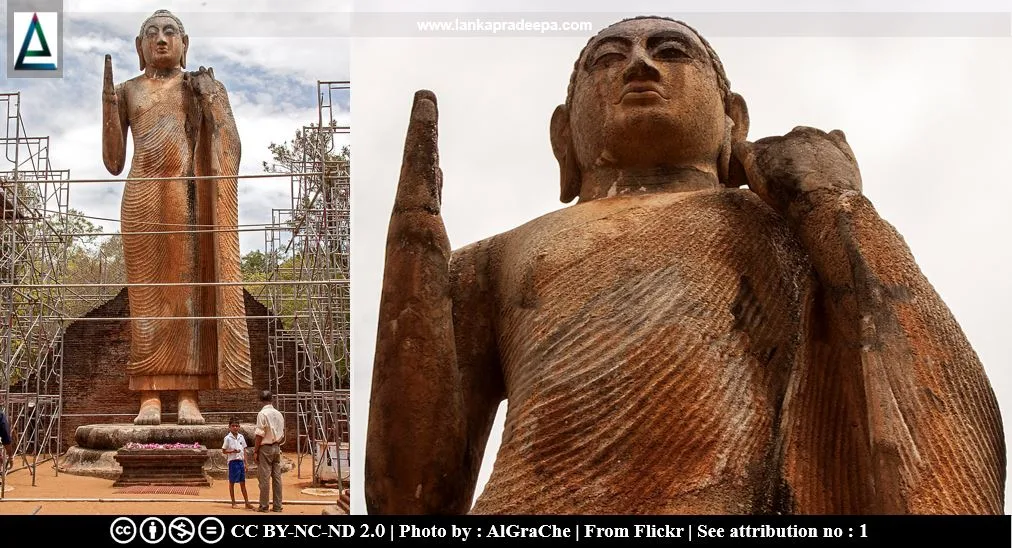
Maligawila Buddha Statue (Sinhala: මාළිගාවිල බුද්ධ ප්රථිමාව) is an ancient rock-cut Buddha statue located in Maligawila (also pronounced Maligawela) in Monaragala District, Sri Lanka. It is the tallest Buddha statue in the country carved in the round (Chutiwongs et al., 2007).
History
It is believed that Maligawila is the ancient Kanagama where, according to Mahavamsa, a large image house was built by King Aggabodhi IV [(667-683 A.D.) Chutiwongs et al., 2007; Silva et al., 1990]. It is also mentioned that the king built a 15 feet high Bodhisattva Maitreya together with a large Buddha image and donated it to the Ariyakari Viharaya (Chutiwongs et al., 2007). The Dambegoda Bodhisattva Statue which is located near Maligawila is thought to be that Bodhisattva image built by the king (Chutiwongs et al., 2007). In ancient times Maligawila and Dambegoda remained as one monastery site (Nicholas, 1963; Silva, 1990).
Scholars have dated this statue to the 7th-8th century A.D. (Chutiwongs et al., 2007).
The statue
The statue is 41 feet 10 inches tall (including the pedestal) and has been carved out from a crystalline limestone (marble) block (Chutiwongs et al., 2007; de Jayawardena, 2015). The face is round and it is adorned with half-closed eyes and long ears (Lambakarna). The robe is closely touching the Buddha's body but leaves the right shoulder bare. The ripples of the robe are shown by regular concave ridges.
The right hand of the statue is in the pose of Abhaya-mudra (Chutiwongs et al., 2007). The left hand is in the ring-hand attitude holding the edge of the robe. Ruins around the statue indicate that an image house had been constructed around the statue.
Conservation
The statue had been broken into several pieces by the time it had been found in 1951 (de Jayawardena, 2015). It is said that the Buddha statue along with the nearby Dambegoda Bodhisattva statue had been blasted by vandals using dynamite around 1948 (Silva, 1990). However, in 1980 the statue was reconstructed with the latest techniques and raised again (de Jayawardena, 2015).
Archaeological Museum
A small site museum of the Archaeological Department has been established near the Maligawila Buddha statue premises. The museum is used to exhibit antiquities
recovered from the area.
Attribution
References
1) Chutiwongs, N.; Prematilleke, L.; Silva, R., 2007. Sri Lanka Murthi: Buddha (Sri Lanka Sculpture: Buddha). Central Cultural Fund. Ministry of Cultural Affairs. pp.58-59.
2) de Jayawardena, U.S., 2015. A study on the present states of different rocks of ancient monuments in Sri Lanka. In Engineering Geology for Society and Territory-Volume 8 Springer, Cham.pp.43-46.
3) Nicholas, C. W., 1963. Historical topography of ancient and medieval Ceylon. Journal of the Ceylon Branch of the Royal Asiatic Society, New Series (Vol VI). Special Number: Colombo. Royal Asiatic Society (Ceylon Branch). p.53.
4) Silva, R., Wijesuriva, G. and Wysse, M., 1990. Restoration of a vandalized Bodhisattiva image of Dambegoda, Sri Lanka. Icomos information, (1), pp.18-25.
Location Map
This page was last updated on 4 June 2022
For a complete tourist map follow this link: Lankapradeepa Tourist Map
For a complete tourist map follow this link: Lankapradeepa Tourist Map

